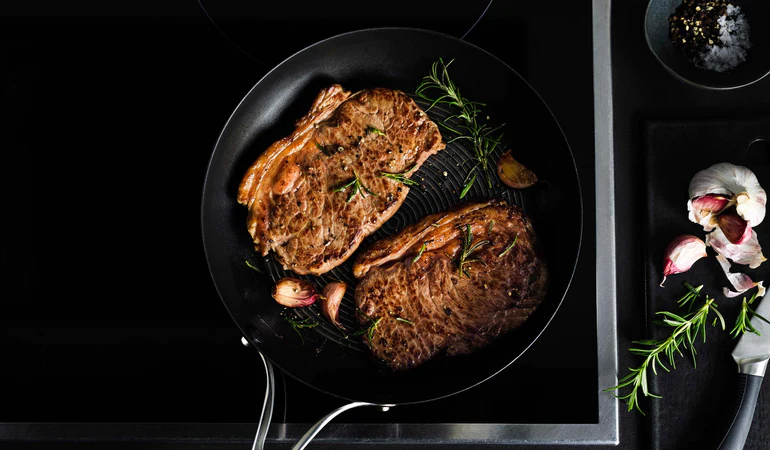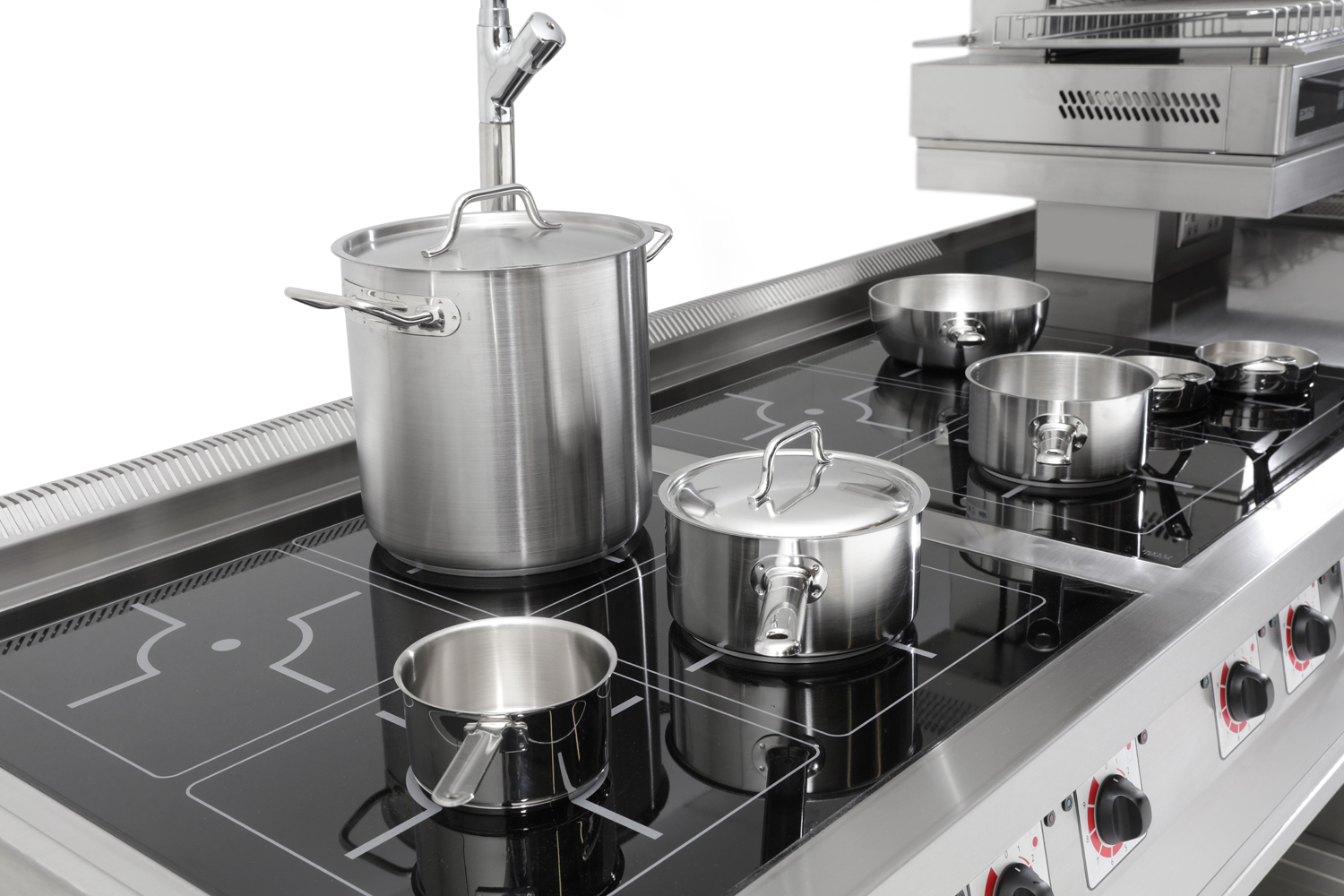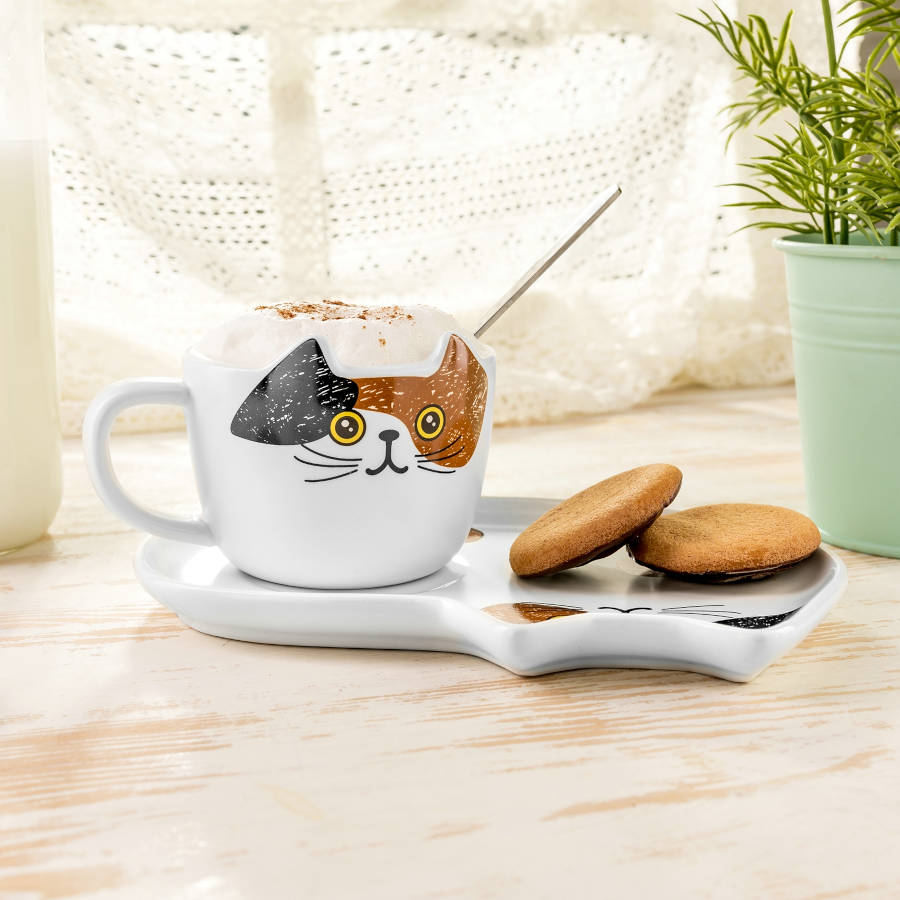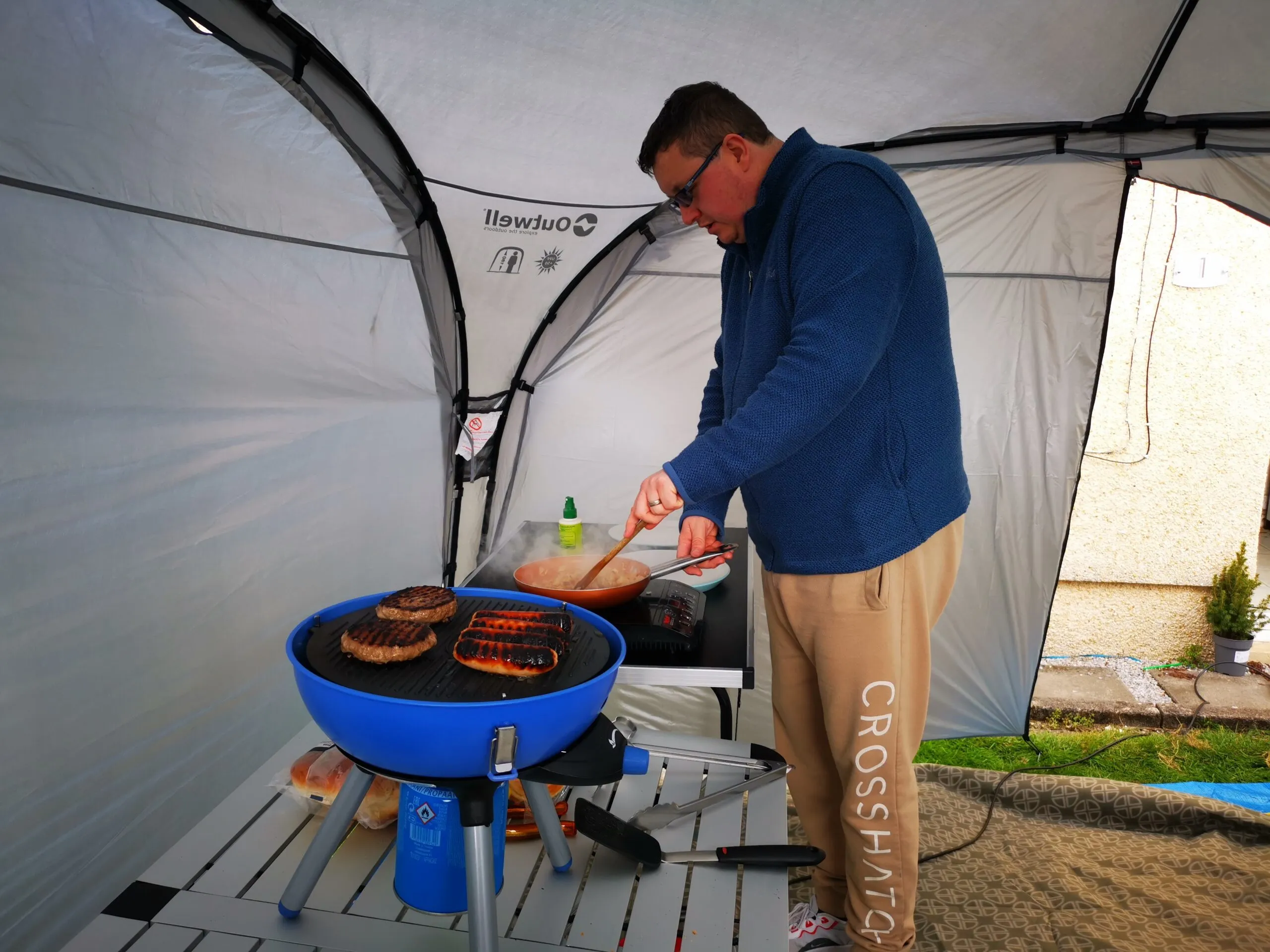Yes, you can use induction pans on an electric hob as long as the cookware is induction-compatible. Besides, there are a few essential considerations to keep in mind, and here they are:
- Induction pans should be made of magnetic materials.
- The pan’s bottom must be flat and have good contact with the hob.
- The pan’s size should match the heating element.
- Look for an induction-compatible label or marking on the pan.
- Opt for high-quality induction pans for better performance.
- Exercise caution when adjusting temperature settings on the hob.
Understanding Induction Pans
What are induction pans?
Induction pans, often referred to as induction-compatible or induction-ready pans, are cookware designed for use on induction cooktops. These pans are specially constructed to work efficiently with induction cooking technology.
How do they work on induction cooktops?

Induction pans work on induction cooktops through a process known as electromagnetic induction. Induction cooktops employ a magnetic field to create heat directly within the pan rather than warming the surface of the cooktop. Here’s a breakdown of the process:
- Magnetic Material: Induction pans must be made of a magnetic material, such as cast iron or certain types of stainless steel. These materials are responsive to the magnetic field created by the induction cooktop.
- Electromagnetic Field: When you place an induction pan on the cooktop, the cooktop generates a high-frequency alternating current (AC) through a copper coil beneath the glass surface. This current creates an electromagnetic field.
- Eddy Currents: The magnetic field induces eddy currents in the magnetic pan’s bottom. These eddy currents generate heat due to resistance, following the principle of Joule heating. This heat is transferred to the contents of the pan, cooking your food.
- Precise Control: Induction cooktops offer precise and immediate control of temperature, as the heat is generated directly in the pan. When you adjust the temperature setting, the changes are nearly instantaneous.
- Safety: Induction cooking is generally considered safer than traditional gas or electric cooking because the cooktop surface remains cool to the touch. The heat is only produced in the pan, reducing the risk of burns.
Materials suitable for induction pans:
Cast Iron: Cast iron is an ideal selection for induction cooking due to its impressive magnetic permeability and its ability to retain and distribute heat, ensuring even cooking effective.
Cast iron skillets and Dutch ovens are frequently preferred choices for this purpose.
Stainless Steel with Magnetic Base: Not all stainless steel is induction-compatible, but those with a magnetic base (usually made of iron or a combination of iron and steel) work well. Look for pans labeled as “induction-ready” or “magnetic stainless steel.”
Carbon Steel: Carbon steel pans are similar to cast iron and work effectively on induction cooktops. They are lightweight and heat up quickly, making them suitable for various cooking tasks.
Magnetic Stainless Steel: Some high-quality stainless-steel cookware is made with a magnetic layer on the bottom to ensure compatibility with induction cooktops. These pans are typically more expensive but offer the benefits of stainless steel.
Enamel-coated Cast Iron: Some enamel-coated cast iron cookware is induction-compatible. The enamel layer prevents rust and makes the pans easier to clean.
Induction-Ready Nonstick Pans: Some nonstick pans are designed with a magnetic base for use on induction cooktops. However, it’s essential to choose high-quality nonstick cookware to ensure durability.
When purchasing induction pans, look for a label or description that specifies their compatibility with induction cooktops to ensure they will work effectively with your cooking appliance.
Electric Hobs Explained
Overview of electric hobs:
Electric hobs, also known as electric cooktops or stovetops, are a type of cooking appliance that uses electricity to generate heat for cooking. They are commonly found in kitchens and are available in various designs and configurations.
Electric hobs are a favored option among numerous households, appreciated for their user-friendly operation, safety enhancements, and precise management of cooking temperatures. Here’s a concise overview of electric hobs:
- Heating Elements: Electric hobs typically feature one of the following types of heating elements:
- Coil Elements: These are traditional spiral-shaped heating elements made of metal. They are visible on the cooktop and transfer heat to the cookware through direct contact.
- Solid Disk Elements: These elements are flat, solid metal disks that heat up when electricity is applied.
- Glass-Ceramic Elements: These are flat, smooth surfaces made of glass-ceramic material. They contain heating elements underneath the surface, which heat the cookware placed on top.
- Control Panel: Electric hobs are equipped with a control panel that empowers users to fine-tune the temperature settings for individual heating elements.
- Depending on the model, these controls may feature touch-sensitive interfaces or utilize traditional knobs and dials for temperature adjustments.
- Safety Features: Electric hobs often include safety features such as indicator lights to show when a heating element is hot, automatic shutoff timers, and child safety locks.
- Ease of Cleaning: Glass-ceramic electric hobs are easy to clean because of their smooth, flat surface. Spills and food residue can be wiped away with a damp cloth once the cooktop has cooled down.
- Precise Temperature Control: Electric hobs offer precise temperature control, making them suitable for a wide range of cooking techniques, from simmering to high-heat searing.
How electric hobs differ from other types of cooktops:
Electric hobs differ from other types of cooktops in several ways, including their heating methods, advantages, and disadvantages. Here’s a comparison with gas and induction cooktops:
Gas Cooktops:
- Heating Method: Gas cooktops use an open flame or gas burner to heat cookware directly. They provide instant heat and precise control over the flame’s intensity.
- Differences: Chefs often prefer gas cooktops due to their quick responsiveness and the visual indicator provided by the flame.
- However, it’s worth noting that they can be a bit more challenging to master and necessitate access to a natural gas or propane supply.
- Induction Cooktops:
- Heating Method: Induction cooktops use magnetic fields to induce heat in magnetic cookware. They generate heat directly in the cookware, making them energy-efficient and safe.
- Differences: Induction cooktops are known for their rapid heating and precise temperature control. They are also safer due to the absence of open flames and the cool cooktop surface. However, they require induction-compatible cookware.
Advantages of Electric Hobs:
- Ease of Use: Electric hobs are easy to operate and require a minimal learning curve.
- Safety: They often feature safety features like indicator lights and automatic shutoff.
- Cleanliness: Glass-ceramic electric hobs are easy to clean and maintain.
- Disadvantages of Electric Hobs:
- Slower Heating: Electric hobs can be slower to heat up compared to gas or induction cooktops.
- Energy Efficiency: They may be less energy-efficient compared to induction cooktops.
- Cookware Compatibility: Certain types of cookware, such as non-magnetic ones, may not work on electric hobs.
The choice between gas, electric, or induction hobs depends on individual preferences, cooking style, and the availability of specific utilities in the kitchen. Each type of cooktop has its unique features and advantages.
Clarification of the key factors for compatibility:
Pan Material: Induction pans are typically made of magnetic materials, such as cast iron, magnetic stainless steel, or certain types of steel with a magnetic bottom.
These materials are vital because they react to the magnetic field produced by the induction cooktop.
When using induction pans on an electric hob, make sure your electric cookware is also made of a magnetic material.
Flat Bottom Requirement: Both induction and electric hobs require cookware with a flat and smooth bottom.
A flat bottom ensures even contact with the heating element or the electric coil on the cooktop. Pans with warped or uneven bottoms may not heat evenly, which could lead to cooking issues.
Pan Size Matching: Match the pan size to the electric hob’s heating element.
Using a pan that’s significantly smaller or larger than the heating element can result in inefficient heating and longer cooking times. It’s important to choose the right-sized pan for the burner you plan to use.
Induction-Ready Label: While induction pans are specifically designed for induction cooktops, not all induction-compatible pans may have an induction-ready label. If you’re using an induction pan on an electric hob, it’s helpful to check for this label to confirm its suitability.
Cookware Quality: The quality of your cookware is important for efficient cooking. Cheap or thin cookware may not distribute heat evenly, leading to hot spots and potential burning.
High-quality induction pans tend to perform better on both induction and electric hobs.
Control Settings: Electric hobs offer different control settings for temperature adjustment. While induction cooktops provide precise and immediate temperature control, electric hobs may have a bit of a lag in adjusting the heat.
You may need to adjust the settings on the electric hob to match the desired cooking temperature, which might require some trial and error.
In summary, you can use induction pans on an electric hob, but it’s crucial to ensure that the pan material is magnetic, the bottom is flat, the size matches the heating element, and the pan is of good quality.
While the performance may not be as precise as on an induction cooktop, you can still achieve effective cooking results with the right considerations and adjustments to the control settings.
Benefits of Induction Pans on Electric Hobs
The advantages of using induction pans
Using induction pans on electric hobs can offer several benefits, making them a versatile choice for your cooking needs.
Efficient and Precise Cooking:
Rapid Heating: Induction pans are known for their quick and efficient heating. When using induction pans on an electric hob, you can take advantage of this rapid heating capability, which can save you time and energy. The pan heats up quickly, reducing your waiting time.
Precise Temperature Control: Induction pans provide precise and immediate control over cooking temperatures. This level of control is beneficial for various cooking techniques, from delicate simmering to high-heat searing.
On an electric hob, you can still achieve precise temperature adjustments, allowing you to fine-tune your cooking to perfection.
Even Heating: Induction technology ensures even distribution of heat across the entire cooking surface. This means your food is less likely to have hot spots or uneven cooking. Using induction pans on an electric hob can help maintain this even heating quality.
Safety Features:
Cool Cooktop Surface: One of the significant safety advantages of induction pans is that the cooktop surface remains cool to the touch. This is true when using them on induction cooktops, and it also applies when using them on electric hobs.
The electric hob’s surface remains cool to the touch, minimizing the risk of burns and enhancing safety, especially in households with children.
Automatic Shutoff: Many induction pans and induction-compatible electric hobs come with safety features like automatic shutoff. This feature can be crucial in case you forget to turn off the cookware. It helps prevent overheating and potential hazards.
Indicator Lights: Some induction pans have indicator lights that show when the cookware is hot, even when used on electric hobs. This visual cue helps prevent accidental contact with hot surfaces.
Child Safety Locks: If your electric hob has child safety locks, these features can help keep children from accidentally turning on the cooktop.
In summary, using induction pans on electric hobs combines the benefits of efficient and precise cooking with the safety features of induction technology.
It allows you to take advantage of induction pans’ quick heating and precise temperature control while still benefiting from the safety features provided by electric hobs, such as a cool cooktop surface and safety locks.
Tips for Using Induction Pans on Electric Hobs

How to make the most of your induction cookware
- Choose Quality Induction Pans: Invest in high-quality induction pans made of magnetic materials, such as cast iron or magnetic stainless steel. Quality cookware ensures better heat distribution and longevity.
- Flat Bottom Pans: Ensure your induction pans have a flat and smooth bottom. A good, even contact with the heating element on the electric hob is essential for efficient cooking.
- Match Pan Size: Use pans that match the size of the heating element on your electric hob. This ensures even heating and efficient energy use.
- Induction-Ready Label: If possible, opt for induction pans with an “induction-ready” label.
While it’s not a strict requirement for using them on electric hobs, it’s an indication of their compatibility with induction cooking, which can translate to efficient performance on an electric hob as well.
Temperature Control:
- Be Mindful of Control Settings: Electric hobs may have a slightly different control system than induction cooktops. Pay attention to the control settings and how they affect the heat. You may need to experiment to find the right setting for your desired cooking temperature.
- Start at a Lower Setting: When using induction pans on an electric hob, it’s often a good practice to start at a lower heat setting and gradually increase it if necessary.
Electric hobs may have a lag in temperature adjustment compared to induction cooktops, so starting lower can help prevent overheating your pan.
- Use Medium to Low Heat for Most Cooking: For most cooking tasks, using medium to low heat settings is often sufficient. The precise control of electric hobs allows you to achieve the desired results without high heat levels.
Safety Precautions:
Cool Down Before Cleaning: Even when used on an electric hob, induction pans can become very hot. Allow them to cool down before cleaning. Always follow safety guidelines for handling hot cookware.
Use Oven Mitts or Pot Holders: To safeguard your hands from hot handles and lids when working with induction pans on an electric hob, it’s advisable to use oven mitts or pot holders.
Keep Cooktop Clean: Regularly clean your electric hob to prevent burnt-on food residue. This not only enhances safety but also ensures efficient heat transfer to your induction pans.
Child Safety: If you have children in your home, take advantage of any child safety locks or features on your electric hob to prevent unintended use.
Unplug or Turn Off: When you’re done cooking, unplug or turn off the electric hob. Even when it’s not actively heating, the surface can remain warm for a while.
Be Aware of Electrical Connections: Ensure that the electric hob is properly connected and the power supply is in good condition. Faulty wiring or connections can be dangerous.
FAQs
Can you use induction pans on an electric hob?
Yes, you can use induction pans on an electric hob, but there are some considerations to keep in mind.
What is an induction pan?
An induction pan is a specific type of cookware crafted for use on induction cooktops. It is constructed from magnetic materials that interact with the magnetic field produced by the cooktop.
Do I need special pans for an electric hob with induction elements?
Yes, you should use pans that are compatible with induction cooktops. They should be made of magnetic materials like stainless steel or cast iron.
What happens if I use non-induction pans on an electric hob with induction elements?
Non-induction pans will not heat up properly on induction hobs as they don’t respond to the magnetic field, and cooking will be inefficient or non-existent.
How do I know if a pan is induction-ready?
Look for an “induction-compatible” or “induction-ready” label on the pan. Manufacturers often specify this information on the packaging.
Can I use any size of induction pan on an electric hob?
Ideally, you should match the size of the pan to the size of the induction heating element for efficient and even cooking.
Is there any specific maintenance required for induction pans on an electric hob?
No, there is no specific maintenance required for induction pans on an electric hob.
Maintenance is similar to other cookware. Keep the bottom clean and flat, and avoid using abrasive cleaning methods that might damage the pan’s surface.
Do induction pans work as well on an electric hob as on an induction cooktop?
Yes, induction pans work as well on an electric hob as on an induction cooktop.
Are there any safety concerns when using induction pans on an electric hob?
No, there are generally no safety concerns when using induction pans on an electric hob.
Induction pans are generally safe to use, and electric hobs with induction elements offer additional safety features, such as automatic shutoff when no pan is detected.
Can I use copper or glass cookware on an electric hob with induction elements?
Copper and glass cookware typically do not work on induction cooktops as they are not magnetic materials.
What are the benefits of using induction pans on an electric hob?
Benefits include fast and precise cooking, energy efficiency, safety features, and ease of cleaning, making them a popular choice for many home chefs.
Conclusion
In conclusion, using induction pans on electric hobs is a practical and efficient way to enhance your cooking experience.
By selecting quality induction cookware, paying attention to temperature control, and adhering to safety precautions, you can maximize your cookware while enjoying the benefits of both induction and electric cooking technologies.
This combination allows for precise and efficient cooking, even heating, and safety features like a cool cooktop surface.
Whether you’re a seasoned chef or a home cook, these tips help you achieve excellent results while ensuring a safe and enjoyable cooking environment.










